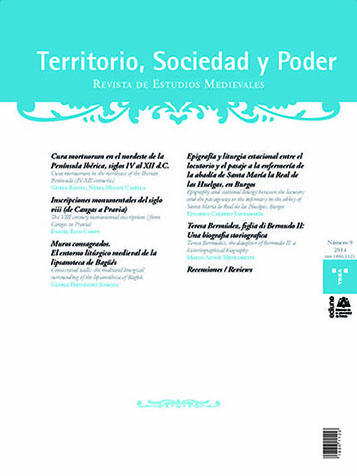Resumen
Resumen: En el presente trabajo presentamos la dinámica del culto a los muertos en el nordeste de la Península Ibérica a partir de pruebas arqueológicas y textuales entre los siglos IV y XII. Los problemas tratados se inscriben en una perspectiva general que permiten contextualizar y comprender las manifestaciones funerarias del este de la antigua Tarraconense analizando el vocabulario así como aspectos historiográficos y arqueológicos, que facilitan la comprensión de los antiguos ritos funerarios. Para reconstruir la significación del espacio hemos acotado el estudio de las necrópolis a su localización respecto al hábitat y la iglesia, delimitación y organización interna, topografía de las sepulturas, habitaciones funerarias y mausoleos, circulación y señalización de las tumbas, complejidad tipológica y problemas de datación. El nordeste peninsular ofrece, en el paso de la Antigüedad tardía al mundo medieval, un gran abanico de ejemplos, tanto urbanos como rurales, que permiten acercarnos a la muerte y como el hombre se enfrentó a ella.
Palabras clave: Antigüedad tardía. Alta Edad Media. Arqueología funeraria. Culto a los muertos.
Abstract: This paper on the cura mortuorum will focus on the cult of the dead according to the archaeological and documentary evidence in the northeastern Iberian Peninsula during the 4th to 12th centuries. The problems examined correspond to a precise territory and period but also form part of a wider overview which aims to contextualize and understand funerary practices in the northeast of what was Roman Tarraconensis. Observations of the vocabulary as well as historiographical and archaeological aspects, all of which provide a means to understand ancient funerary rites, will be explored so as to reconstruct the nature of space in the context of the burial of the dead. A number of significant problems relevant for the study of cemeteries follow: the site, location with respect to settlement and churches, boundaries and internal organization, the topography of burials, funerary chambers and mausolea, circulation between the burials, and identification of the tombs, as well as the complexity of the typology and dating problems. The northeastern Iberian Peninsula, in the transition from Late Antiquity to the Middle Ages, offers a wide range of examples, some well studied, which, despite the heterogeneity of the urban and rural corpus, allows us to reconstruct death and how man faced it, recalling the title of the well known work by Ph. Airès, L’homme devant la mort (1977). Death, in the Christian West, was accompanied by ceremonies and rituals thoroughly dominated by the terror of the Final Judgment and of the Apocalypse of the year 1000, a destiny of catastrophe which forced society to live in a world of guilt and culpability in the face of the ever nearing end of the world.
Keywords: Late Antiquity. Early Middle Ages. Funerary Archaeology. Cult of the dead.

